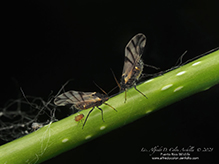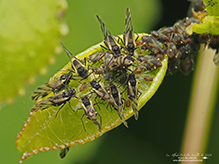poplar leaf aphid
(Chaitophorus populicola)
Conservation • Description • Habitat • Ecology • Distribution • Taxonomy
|
|
||||||||||||||
Description |
Poplar leaf aphid is a common, small aphid. It occurs throughout the United States and southern Canada. Poplar leaf aphids are found often in dense colonies on poplars and cottonwoods (Populus spp.). They feed on the growing tips (meristems) of young shoots, developing leaves, and leaf stalks (petioles). They are attended by many species of ants, including furrowed ants; carpenter ants; wood, mound, and field ants; and the odorous house ant. They are found only where they are attended by ants. The ants feed on the carbohydrate-rich honeydew exuded by the aphids. In return the ants protect the aphids from natural enemies. Adult females are either wingless or winged. Unwinged female adults (apterae) are 1⁄16″ (2 to 2.5 mm) in length. The body is soft, hairy, somewhat pear-shaped, and yellowish brown (pale) to shiny black (dark). It is never covered with wax. The head and the upper plate on the first segment of the thorax (pronotum) are fused. The antennae have 6 segments, and they are shorter than the body. The third segment is pale and very long. The remaining segments are dark. The are two conspicuous compound eyes with many facets. On top of the head there are three simple eyes (ocelli) in a broad triangle. On the rear side margin of each compound eye there is another small eye (triommatidium) with just three facets. The beak-like projection of mouthparts (rostrum) is short. The upper plate (tergite) on the last segment of the thorax and on abdominal tergites 1 through 3 may be partly or entirely pale. There is no pale longitudinal line in the middle of the pronotum or on the abdomen. Abdominal tergites 2 through 7 are entirely fused into a single hard plate. There is a pair of elongated processes (cornicles) near the end of the abdomen. The cornicles are small, stump-like, and pale. The tail-like appendage (cauda) is short and rounded with no apparent constriction. Winged females (alates) have dark cross bands on each abdominal segment. The head and pronotum are not fused. The forewings have dark veins with conspicuous dark borders. |
Size |
Total length: 1⁄64″ to 3⁄16″ (0.5 to 4.5 mm) |
Similar Species |
Habitat |
|
Ecology |
Season |
May through August |
Behavior |
|
Life Cycle |
|
Food |
Plant juices |
Distribution |
||
|
Sources |
|
| 1/21/2025 | ||
Occurrence |
||
Common |
||
Taxonomy |
|
Order |
Hemiptera (True bugs, Hoppers, Aphids, and Allies) |
Suborder |
Sternorrhyncha (plant-parasitic hemipterans) |
Infraorder |
Aphidomorpha (aphids and allies) |
Superfamily |
Aphidoidea |
Family |
Aphididae (aphids) |
Subfamily |
Chaitophorinae |
Tribe |
Chaitophorini |
Genus |
Chaitophorus |
Subordinate Taxa |
|
poplar leaf aphid (Chaitophorus populicola patchae) poplar leaf aphid (Chaitophorus populicola populicola) |
|
Synonyms |
|
Chaitophorus bruneri Chaitophorus patchae Periphyllus populicolus |
|
Common Names |
|
American poplar leaf aphid cloudy-winged cottonwood aphid poplar leaf aphid smokey poplar aphid smokeywinged poplar aphid smokey-winged poplar aphid |
|
Glossary
Meristem
The actively growing tip of a plant shoot or root.
Ocellus
Simple eye; an eye with a single lens. Plural: ocelli.
Petiole
On plants: The stalk of a leaf blade or a compound leaf that attaches it to the stem. On ants and wasps: The constricted first one or two segments of the rear part of the body.
Pronotum
The exoskeletal plate on the upper side of the first segment of the thorax of an insect.
Rostrum
The stiff, beak-like projection of the carapace or prolongation of the head of an insect, crustacean, or cetacean.
Tergite
The upper (dorsal), hardened plate on a segment of the thorax or abdomen of an arthropod or myriapod.
Visitor Photos |
||
Share your photo of this insect. |
||
This button not working for you? |
||
Alfredo Colon |
||
 |
 |
|
MinnesotaSeasons.com Photos |
||
|
||
|
||

Visitor Videos |
||
Share your video of this insect. |
||
This button not working for you? |
||
|
Other Videos |
||
Ants (Formica oreas) defending Poplar Leaf Aphids (Chaitophorus populicola) on Stem |
About
Jun 1, 2012 Photographed at the Turtle River State Park, North Dakota (30 May 2012). Go here to learn more: https://www.sciencedaily.com/releases/2007/10/071009212548.htm |
Ant (Formica oreas) tending Poplar Leaf Aphids (Chaitophorus populicola) on Leaf |
About
Jun 1, 2012 Photographed at the Turtle River State Park, North Dakota (30 May 2012). Go here to learn more: https://www.sciencedaily.com/releases/2007/10/071009212548.htm |
Ants farming aphids |
About
Sep 29, 2024 Carpenter ants, camponotus herculeanus (identified via google image search (may or may not be accurate)), farming smoky poplar aphid, chaitophorus populicola (also identified via google image search) on a small poplar tree. I took this video in 2022. |

|
Created: 1/21/2025 Last Updated: © MinnesotaSeasons.com. All rights reserved. |





